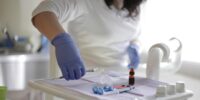What Is Woman Breast Health and Self-Examination Tips

In the journey of life, amidst the symphony of responsibilities and aspirations, it is crucial for women to prioritize their health and well-being. The delicate balance lies in nurturing the mind, body, and soul, and one aspect that demands our utmost attention is breast health.
Through the power of self-examination, we can become vigilant guardians of our bodies, detecting any abnormalities and seeking timely medical care.
This article aims to provide valuable insights and tips to empower women in their pursuit of optimal breast health.
Key Takeaways
- Breast health awareness and early detection are crucial for preventing and successfully treating breast cancer.
- Self-examination techniques empower women to take control of their health and detect breast abnormalities early.
- Being aware of signs and symptoms of breast abnormalities, such as changes in size or shape, nipple discharge, and lumps, is important for prompt reporting to a healthcare professional.
- Maintaining a balanced diet, engaging in regular physical activity, and minimizing exposure to known risk factors are lifestyle factors that contribute to maintaining breast health.
The Importance of Breast Health Awareness
The Importance of Breast Health Awareness cannot be overstated, as it plays a crucial role in early detection and prevention of breast cancer. Breast cancer prevention starts with being knowledgeable about breast health and understanding the importance of regular self-examinations.
Breast health education is essential in empowering women to take charge of their own well-being. By promoting breast health awareness, women can learn how to recognize any changes in their breasts and seek medical attention promptly. Early detection of breast cancer greatly increases the chances of successful treatment and survival.
Breast health education also emphasizes the importance of regular screenings, such as mammograms, which can detect breast cancer even before any symptoms are present. By focusing on breast health awareness, we can empower women to take proactive steps towards preventing breast cancer and promoting overall well-being.
Understanding Self-Examination Techniques
Understanding self-examination techniques is crucial for women to effectively monitor their breast health and detect any potential abnormalities. Regular self-examinations provide numerous benefits, including early detection of breast cancer, increased familiarity with one’s own body, and empowerment in taking control of one’s health.
To perform a self-examination, women should follow certain guidelines. Start by standing in front of a mirror and visually inspecting the breasts for any changes in size, shape, or skin texture. Then, use the pads of the fingers to feel for any lumps or thickening in the breast tissue. It is important to examine the entire breast, including the armpit and collarbone area. Women should also be aware of any changes in nipple appearance or discharge.
If any abnormalities are detected, it is crucial to consult a healthcare professional for further evaluation. By practicing regular self-examinations, women can play an active role in maintaining their breast health and potentially detect any issues early on.
Signs and Symptoms of Breast Abnormalities
Early detection of breast abnormalities can be facilitated by recognizing signs and symptoms through regular self-examinations. It is important for women to be aware of the potential indicators of breast abnormalities, as early detection greatly increases the chances of successful treatment and improved outcomes.
Some common signs to look out for include changes in breast size or shape, nipple discharge, redness or dimpling of the skin, and the presence of lumps or thickening in the breast tissue. Any of these symptoms should be promptly reported to a healthcare professional for further evaluation.
By being vigilant and proactive in conducting regular self-examinations, women can play an active role in their breast health and contribute to early detection.
Transitioning into the subsequent section about lifestyle factors for maintaining breast health, it is crucial for women to adopt healthy habits and make informed choices to reduce their risk of developing breast abnormalities.
Lifestyle Factors for Maintaining Breast Health
In order to promote optimal breast health, it is essential for women to prioritize lifestyle factors such as maintaining a balanced diet, engaging in regular physical activity, and minimizing exposure to known risk factors. Preventive measures and healthy habits play a crucial role in reducing the risk of breast cancer and other breast abnormalities.
A balanced diet rich in fruits, vegetables, whole grains, and lean proteins provides essential nutrients and antioxidants that support breast health. Regular physical activity, such as brisk walking or jogging, helps maintain a healthy weight and reduces the risk of breast cancer. Minimizing exposure to known risk factors such as excessive alcohol consumption and smoking also contributes to overall breast health.
To further emphasize the importance of these lifestyle factors, here is a table highlighting their impact on breast health:
| Lifestyle Factor | Impact on Breast Health |
|---|---|
| Balanced Diet | Provides essential nutrients and antioxidants |
| Physical Activity | Reduces the risk of breast cancer |
| Minimizing Risk Factors | Decreases the likelihood of breast abnormalities |
Seeking Medical Care and Support for Breast Health Concerns
Women should prioritize seeking medical care and support for their breast health concerns to ensure timely diagnosis and personalized treatment options. Seeking medical advice and breast health support is crucial in identifying any potential issues early on and taking appropriate action.
Regular check-ups and screenings, such as mammograms, can detect breast cancer at an early stage when it is most treatable. Additionally, women should be aware of any changes in their breasts and seek medical attention if they notice any abnormalities, such as lumps, changes in size or shape, or nipple discharge.
By seeking medical care and support, women can receive the necessary guidance and expertise to address their breast health concerns and make informed decisions regarding their treatment options.
Frequently Asked Questions
Can Breast Self-Examination Replace Regular Mammograms?
Breast self-examination benefits include early detection of abnormalities, but it cannot replace regular mammograms. Regular mammograms are essential for diagnosing breast cancer at its earliest stages, when treatment is most effective.
How Often Should Women Perform Breast Self-Examinations?
Frequency recommendations for performing breast self-examinations vary, with some experts suggesting monthly self-exams while others emphasize the importance of being familiar with one’s own breasts and reporting any changes promptly. Early detection is crucial for effective breast health management.
What Are the Risk Factors for Developing Breast Cancer?
Breast cancer risk factors include age, family history, genetic mutations, and hormone levels. Prevention strategies focus on maintaining a healthy lifestyle, regular exercise, limiting alcohol consumption, and avoiding hormone replacement therapy.
Are There Any Natural Remedies or Lifestyle Changes That Can Reduce the Risk of Breast Abnormalities?
Natural remedies and lifestyle changes can play a role in reducing the risk of breast abnormalities. Incorporating a balanced diet, regular exercise, limiting alcohol consumption, and avoiding exposure to certain environmental toxins are some ways to promote breast health.
What Are the Different Types of Breast Abnormalities and How Are They Diagnosed?
Breast abnormalities encompass a range of conditions, including cysts, fibroadenomas, and breast cancer. Diagnostic methods such as mammography, ultrasound, and biopsy are used to identify and evaluate these abnormalities, ensuring timely and appropriate treatment.









